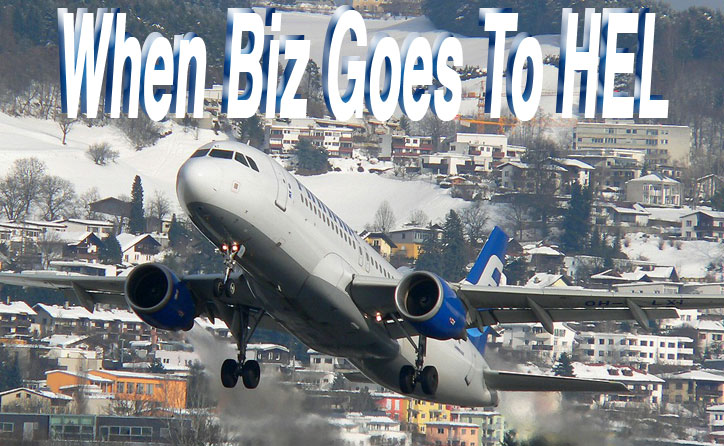When Biz Goes To HEL

Finnair’s India innings
came quite late in comparison to other European carriers. The carrier
launched direct flights between Delhi and Helsinki on October 30, 2006
only to be followed eight months later on June 27, 2007, with a flight
from Mumbai to Helsinki. However, there were only a few takers for the
Mumbai flights and they have been temporarily suspended since March 2009.
On the other hand, the Delhi-Helsinki sector
has done remarkably well. In fact, the six flights a week from Delhi apparently
contributed to the carrier’s 26 percent growth in Asian traffic
this summer. According to reports, the passenger load factor for the first
three months of the year was 91 percent, 84 per cent and over 95 percent,
respectively.
 |
 |
The India cargo unit of the carrier
has done its bit, said a confident Kari Stolbow, (above left) Director,
Indian Subcontinent for Finnair. His colleague Kuldip Singh Kharayat,
(above right) Area - Director - Indian Subcontinent, Finnair Cargo affirmed
with a big smile.
Air Cargo News FlyingTypers talked
to the cargo chief about Finnair’s Delhi connection. Pointing out
that the credit should be given to the aircraft, Kharayat said: “The
A330 is a very fuel efficient aircraft, but the payload carrying capacity
of the aircraft drops with increase in flying time. The Delhi-Helsinki
flight being the shortest flying time to Northern Europe, we can get 17
tons with a full complement of passengers on board. The aggregate average
is 15 tons-plus on flights out of Delhi.”
The airline is, in fact, the only carrier
to North Europe out of the Indian subcontinent.
“This,” said Kharayat, “gives
Finnair Cargo a competitive edge in transits to destinations in the Nordic
and Baltic states, which are our niche markets and focus area.”
Finnair takes cargo from India to 50-odd
destinations in Europe. The cargo head also mentioned that “there
is lot of demand to the U.S. since Finnair operates daily flights to JFK
from Helsinki and we are able to service our customers to New York and
cities around through our interline partners.
Finnair’s cargo traffic is not one-way—incidentally,
this has been the major grouse of many carriers—with the main commodities
from India being leather garments, pharmaceuticals handicrafts and carpets.
On the Helsinki-Delhi sector, “there is demand of infrastructure-related
goods from North Europe to India. As for imports, we are transporting
telecommunication equipment from Sweden and spare parts which are generally
meant for Delhi, Chennai, Mumbai and Bangalore.”
Despite the six flights a week, “there
is not enough perishable exports by air to the Nordic and Baltic States
at the moment,” informed Kharayat. He was quick to add, “in
the event of this (perishable goods) demand growing, Finnair Cargo has
capabilities and is fully prepared to service its customers.”
As Finnair Cargo ramps up services in the
region, keeping in tune with the growing demand for cargo in the Asian
market—the carrier recently launched a freighter service to Hong
Kong and Seoul—Kharayat and Stolbow are both optimistic. The cargo
division, working hand in hand with the passenger, has its presence in
all major cities in India through its GSA.
In fact, Finnair is keen to expand in India.
Stolbow mentioned that “India is our most important destination.
In the nearest future, most of our income will be coming from Asia and
you can’t speak about India above Asia. The fact is we have at the
moment only one flight, only six flights a week. Trust me, it is only
a temporary thing. Aviation has been losing money for many years. Now,
we are seeing the first light at the end of the tunnel. Now when it is
starting to move again, we are in a very good position because we have
just renewed our fleet. We have made all those very painful structural
changes within our company. So in a way we are now ready. We are ready
to get the ball rolling and that’s why we are looking very positively
in the whole of Asia as well as in India.”
Though the carrier has utilized all its
bilateral entitlements, it is serious about cargo loads from the south
of India. Kharayat said, “There is good demand from Chennai and
Kolkata for Nordic destinations and good pharmaceutical demand from Hyderabad
and Mumbai to the Baltic states and Russia.”
One can expect more Finnair flights from
the south of India. For the moment, Finnair is happy, since “air
cargo is showing good growth trends and with additional capacity we will
definite be able to increase cargo volumes on Finnair flights.”
As for the infrastructure, which is the
common concern of all cargo stakeholders in India, the situation is improving,
said Kharayat.
“There is a lot of improvement happening,
but we still have a long way to go. India needs to have aggressive and
time-scheduled implementation of infrastructure development projects.
India is a global IT solution provider, but somewhere we have not paid
enough attention to in-house IT infrastructure, which is not as that in
the developed nations.”
He suggested a solution: “Until we
have these in place and they are at par with global standards, the logistics
chain will always have an element of unpredictability in it.”
Tirthankar Ghosh/Flossie
|





